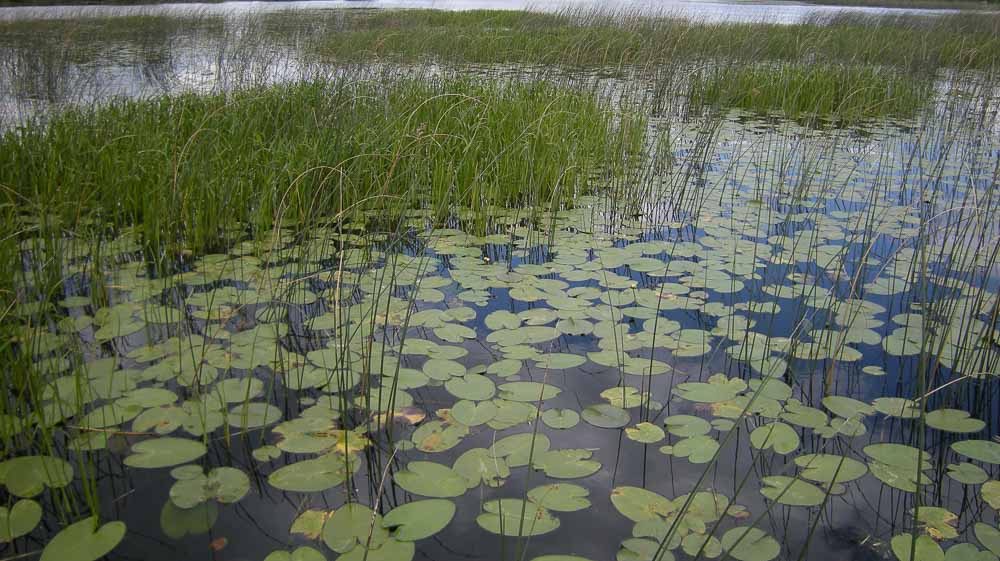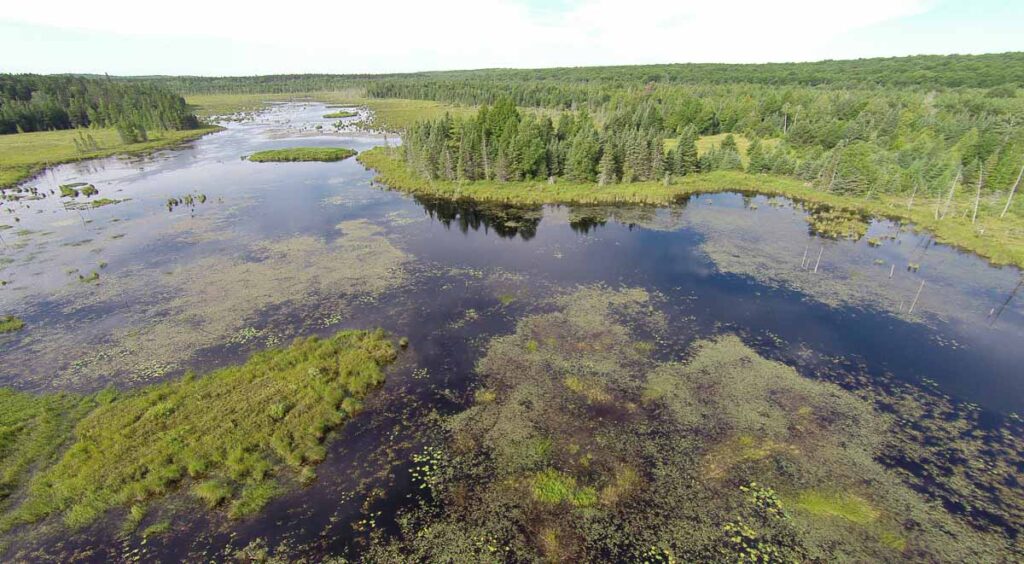Freshwater marshes are wetlands where the water table is above the surface of the ground, and mostly herbaceous vegetation is dominant. In other words, they typically have standing water in them all year. They are productive ecosystems with abundant plant and animal life. Many freshwater marshes are susceptible to drying out seasonally or during a severe drought. Plants and animals that live in marshes must have adaptations to survive dry periods. Drought is an essential part of the life cycle of many wetland plants. Hard and softstem bulrush plants’ seeds will not germinate under water and require drier periods to reproduce sexually.

Like many other wetlands, marshes were once thought of as wasted land because the soil was not suitable for farming or building. However, our ancestors took advantage of the natural diversity of wetlands. They harvested ducks and other waterfowl for food and feathers. Wild Rice was a staple of many Native American tribes, and Common Reed was used as a building material by people throughout the world. Wetlands were, and in some places still are, important sources of fur, fodder for livestock, and sources of medicine. In the United States, marshes are less directly utilized than in the past. However, we still take advantage of the many ecological services that marshes provide like flood control, maintaining water quality, groundwater recharge, and carbon sequestration.
Shallow Marshes
Shallow Marshes have a water depth of less than six inches (15 cm). Shallow marshes have many of the plant and animal species found in sedge meadows and deep marshes. These semi-aquatic ecosystems may be void of fish during the drier summer months, but when flooded in spring, they can be crucial spawning areas for some fish like Northern Pike. Some of these wetlands are always free of fish and are important places for frogs, toads and salamanders to reproduce.
Deepwater Marshes
Deepwater Marshes have between six inches to three feet of water (15-91 cm). Many truly aquatic plant species like Hornwort (Ceratophyllum demersum), Common Waterweed (Elodea canadensis), and White Water-Lily (Nymphaea odorata) are found here. Deepwater marsh ecosystems may have fish in them year-round and can be very important for the spawning and rearing of young fish. These wetlands dry out less frequently than shallow marshes but may become dry during a prolonged, severe drought. In northern climates even deep water marshes can freeze to the bottom, limiting their use as fish habitat unless they are connected to a deeper lake or stream.
Time lapse video of a deepwater marsh. Willows, Stiff Arrowhead and a number of other aquatic plants blow in the breeze.
Open Water Marshes and Lake Littoral Zone
Shallow Open Water Wetlands occur in areas from 3 to 6 feet ( about 1-2 meters) in depth. Sometimes the shallow areas of a lake look very much like a marsh. The littoral zone of a lake is defined as the area of the lake in which enough light can penetrate to the bottom to support rooted plants. This depth can be less than a few feet in highly turbid waters, to dozens of feet in crystal clear water. This zone is where much of the productivity of lakes occur. The types of plants that occur here are often the same that appear in deep or shallow marsh environments. These habitats can be similar to deepwater marshes; both rarely dry out completely, but some of the lake or marsh beds may become exposed during droughts, which has a rejuvenating effect on many aquatic and wetland plants.
Marsh Animals
Abundant and highly productive aquatic and wetland plants lead to abundant animal life of all kinds. Hundreds of species of insects and other invertebrates spend part or all of their life cycle hiding and feeding in the thick vegetation. Dragonfly larvae prey on other insects, young fish, and amphibians. The standing water attracts American Toads that lay their eggs and then disperse into the uplands, while Leopard Frogs often spend their whole life cycle in marsh habitat. The Northern Watersnake is a reptile that patrols the thick vegetation looking for a meal of frogs or fish.
Birds are abundant in the marsh too. Canada Geese nest on muskrat lodges and lead their goslings into the water to feed on aquatic plants and the invertebrates they harbor. Black terns nest in clumps of floating vegetation, either alone or in small colonies. These sooty looking terns fly above the marsh looking below for tiny fish and invertebrates to feed their hungry young. Some of the most conspicuous of the birds, spring through fall, are Red-wing Blackbirds who loudly proclaim their territories in spring and gather in huge numbers in the fall. Smaller birds like the Marsh Wren also make their presence known by their melodious singing.

One mammal that lives in the marsh can be responsible for its creation. American Beavers build dams of sticks, mud and rocks. The beaver dams block creeks and small rivers, creating ponds and shallow and deep marshes. While the Muskrat does not create dams and ponds, they are responsible for altering and developing a diverse marsh ecosystem. Muskrats dig up plants, roots and all to feed on and build their lodges. This creates areas of open water in the marsh that might otherwise be a firm mat of roots and living plants.
Marsh Plants
Marsh wetlands are great places to see some amazing plants, but it can take a little work. If you’re lucky, a nearby nature preserve with a boardwalk will let you get access without getting wet. The next best option to rubber boots and chest waders is a canoe, kayak or skiff to get you into the deeper areas of the marsh. Once in the marsh, you’ll be greeted by some of our most beautiful and interesting wildflowers like White Water Lily, Blue Flag Iris, Marsh Milkweed, and Cardinal Flower. Even the plants without showy flowers can be visually striking. The mace-like seed heads of Common Burreed are hard to miss, and the grace of soft stem bulrushes are also an attractive element of marshes.
Marsh Amphibians and Reptiles
American Toad (Anaxyrus americanus)
Green Frog (Rana clamitans)
Northern Leopard Frog (Rana pipiens)
Blanding’s Turtle (Emydoidea blandingii)
Northern Watersnake (Nerodia sipedon)
Marsh Birds
Green Heron (Butorides virescens)
Canada Goose (Branta canadensis)
Forster’s Tern (Sterna forsteri)
Black Tern (Chlidonias niger)
American White Pelican (Pelecanus erythrorhynchos)
Marsh Mammals
American Beaver (Castor canadensis)
Muskrat (Ondatra zibethicus)
Raccoon (Procyon lotor)
Moose (Alces alces)
Marsh Fish
Northern Pike (Esox lucius)
Bigmouth Buffalo (Ictiobus cyprinellus)
Common Carp (Cyprinus carpio)
Central Mudminnow (Umbra limi)
Marsh Plants
Spatterdock (Nuphar avenda)
White Water-Lily (Nymphaea odorata)
Duckweed
Broadleaf Cattail (Typha latifolia)
Narrowleaf Cattail (Typha angustifolia)
Hybrid Cattail (Typha x glauca)
Wild Rice (Zizania spp.)
Tussock Sedge (Carex stricta)
Common Reed (Phragmites australis)
Coontail (Ceratophyllum demersum)
Common Waterweed (Elodea canadensis)
Common Bladderwort (Utricularia vulgaris)
Water Plantain (Alisma subcordatum)
Purple Loosestrife (Lythrum salicaria)
